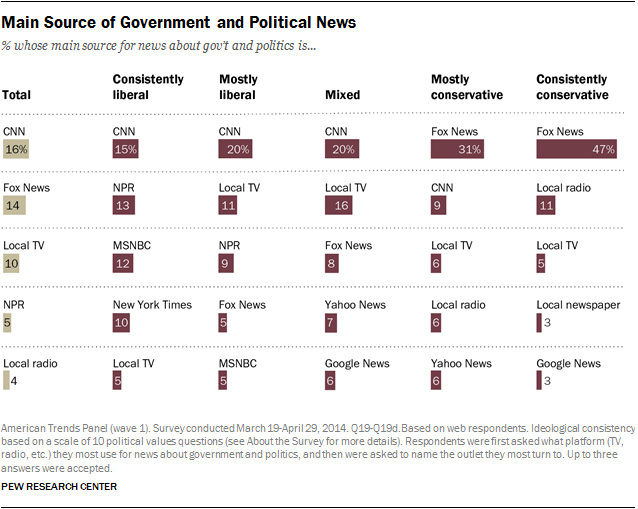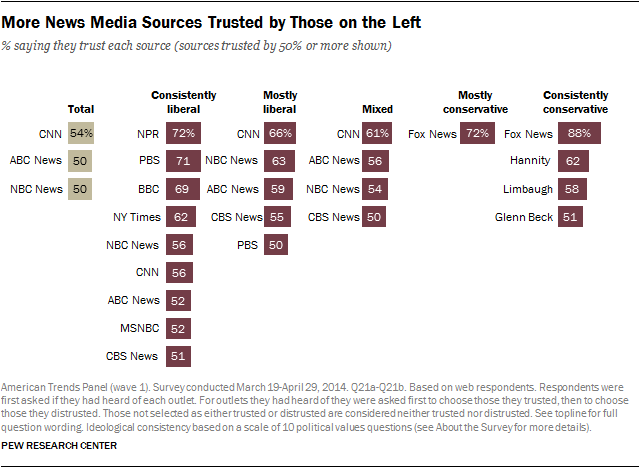The Pew Research Center has one of its ginormous studies out today, this one about polarization and media use, and as usual it's full of interesting stuff. I want to make a point about news in general and NPR in particular, and then after that, for those who care about these things, I have a methodological point to make about how we measure ideology.
One of the distinct things about the Pew results is that conservatives love, love, love Fox News, while no single news outlet has the same kind of near-universal use among liberals. Look, for instance at this chart showing which sources each group cites as their main source of news:

But the really interesting difference emerges when they ask which sources people trust:

You'll notice that for the consistent conservatives, trust is basically a function of ideology and partisanship. The only sources that over 50 percent of them trust are Fox and a bunch of conservative radio hosts (and yes, conservatives would argue that that's because all the mainstream sources have a liberal bias). But the consistent liberals, on the other hand, don't just trust the most ideologically liberal sources the most. MSNBC, for instance, has a bare majority of consistent liberals saying they trust it, while their most trusted news source is NPR.
NPR is a number of things-some people might be thinking of "Fresh Air" or "This American Life" when they answer that question. But chances are most are thinking of the two flagship shows, "Morning Edition" and "All Things Considered," which have by far the network's biggest audiences. These shows are among the most assiduously even-handed presentations anywhere in the American media, but there's a reason why they are so appealing to liberals. They may not have aggressively ideological content, but they do reflect a liberal sensibility. They're careful, reasoned, polite, cosmopolitan, serious with the occasional touch of whimsy-in short, everything liberals either are or imagine themselves to be. And everyone at NPR seems so nice-how could you not trust them? So liberals do, and most of them listen.
Now, on to the methodological discussion. You may know that the number of people who call themselves "conservative" in polls usually outnumbers those who call themselves "liberal" by a substantial margin (around 15 percentage points in the latest Gallup polls). Yet we're supposedly a 50-50 nation, so what's going on? Part of it is that Americans are "symbolic conservatives" but "operational liberals," meaning they like things like small government in the abstract, but also like all the things government does in the particular. Part of it is also that conservatives have spent a few decades now working to make "liberal" an epithet, while there was no countervailing effort on the other side. But in any case, when you look at poll results that divide liberals and conservatives, you're looking at two unequal groups, because the people who call themselves liberals are likely to be strong liberals, while those who call themselves conservatives are a group that is larger and probably more ideologically diverse in some ways.
So what Pew does is instead of just asking people what they are, they ask them a series of ten forced-choice questions about government and particular issues ("Government is almost always wasteful and inefficient" vs. "Government often does a better job than people give it credit for," "The best way to ensure peace is through military strength" vs. "Good diplomacy is the best way to ensure peace," etc.), and using the answers to those questions, they classify them into groups. That gives you a much better sense of what people actually believe, rather than what they think about a pair of ideological labels an alarming number of people have only the dimmest understanding of.
Why don't more pollsters do that? The biggest reason is that ten questions is a huge amount of space on a survey to take up, and it's a lot quicker, easier, and cheaper to just ask one, particularly if you're doing a brief tracking poll. But when Pew does theirs, they get-are you ready-more liberals than conservatives. The spread is as follows: 9 percent consistently conservative, 18 percent mostly conservative, 39 percent mixed, 22 percent mostly liberal, 12 percent consistently liberal. That means a total of 34 percent liberal and 27 percent conservative, with the rest in the middle. In other words, you get about the same number of conservatives this way as you do by just asking what people call themselves, but you get substantially more liberals.
That doesn't necessarily mean that the standard self-identification question is wrong-it does tell you something meaningful. But one should be aware of its limits.



